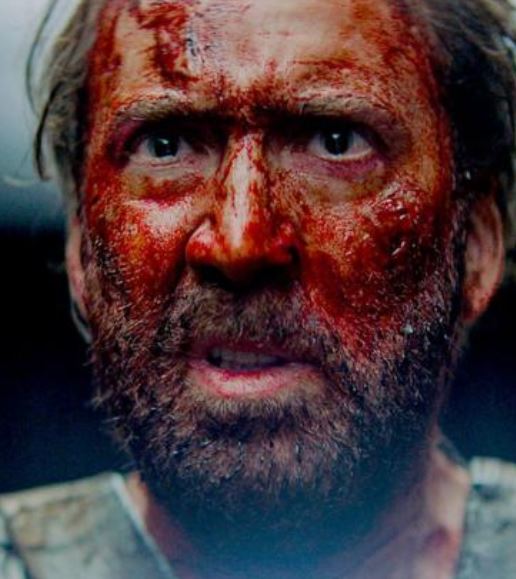@Filmhouse, Edinburgh, from Fri 12 Oct 2018
To say that Mandy is an utterly ridiculous film is neither an exaggeration nor a criticism. Panos Cosmatos’ ludicrous gore-fest starring Nicolas Cage is proof of the words of Edinburgh’s very own Muriel Spark: “There is no contradiction in being both ridiculous and magnificent”. Cage and co-star Andrea Riseborough play Red and Mandy, a couple whose quiet existence in their secluded Pacific Northwest home is destroyed when they are abducted by some demon bikers and taken to a sinister religious cult compound, where they are subject to imprisonment and torture. The second half of the film is an outrageously gruesome revenge thriller as Red, having freed himself, embarks on a bloody, comically macabre, vengeful spree.
The opening credits establish the film’s 80s nostalgia aesthetic, fashionable now as result of the likes of Drive, It Follows and Stranger Things. The retro font of the titles, the grainy quality of the footage, and the period detail, such as an pointed close-up of a record player and the various 80s band t-shirts worn by Mandy, all seem a little laboured. Similarly, the film’s B-movie and giallo-inspired features, such as the synth-heavy, prog-rock soundtrack and the Argento-esque expressionistic saturation of primary colours, feel somewhat heavy-handed. The pace of the first half of the film is pretty dawdling and often dream-like, giving the unfortunate impression at this is an intentionally stylish film that is trying a little too hard and ultimately lacks substance.
Luckily, just as you’re beginning to wonder, with disappointment, if the most restrained element of the film is Nicolas Cage’s acting, there is a dramatic change of pace and tone, allowing the film to become the vehicle for Cage’s idiosyncratic scenery-chomping that, let’s face it, is what we’re really here to see. The film clearly assumes the audience is familiar with Cage’s oeuvre, in particular his often mocked and parodied tendency towards over-the-top displays of emotion, known as “Cage Rage”. Indeed, there is a palpable sense of relief in the auditorium when a disorientated Red, having fled from his captors, arrives home in his underpants and begins dramatically dowsing his wounds in vodka, grunting and gurning, holding his hands in comically claw-like gestures and angrily taking intermittent swigs from the bottle. It’s a very familiar scene, almost as if the YouTube sensation Nicolas Cage Losing His Sh*t has been condensed into mere seconds. This is the first of many deliciously, knowingly preposterous moments that unite the audience in a sense of camaraderie and cause us to laugh out loud.
The film manages to have an ironic, “so bad it’s good” charm without even being necessarily bad. Some scenes are unironically breathtaking. There are glaring plot holes, certainly, and some shockingly cringe-worthy dialogue, but it’s also clear that all of these features are intentional. (The extent to which the use of the racist stereotype of “the mystic negro” in the character of Caruthers, Red’s mentor, is ironic or tongue-in-cheek is less obvious, and therefore perhaps the most genuinely problematic element of the film). Rather than failing or succeeding within a pre-existing genre, either earnestly or as a pastiche, it feels more like Mandy has created its own genre. Or, perhaps it would be more accurate to say that it is the culmination of the work Nicolas Cage has been doing throughout his career, knowingly or otherwise, to create HIS own, personal genre.
Despite the softening and distancing effect the gaudy absurdity has on the depictions of violence, Mandy is definitely not for the faint-hearted. While it’s likely to prove to be a Marmite sort of film for many mainstream audiences, its niche appeal is undeniable, and Mandy will almost certainly be the inspiration behind many a Halloween costume, and probably the subject of many a drinking game.
